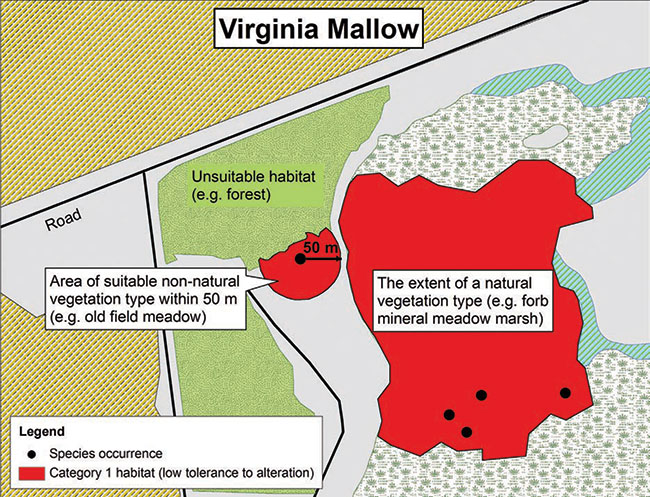Virginia Mallow Habitat Protection Summary
This document provides a brief description of the area that is protected as habitat for the Virginia Mallow through a habitat regulation under the Endangered Species Act.
Virginia Mallow is a globally rare, perennial herb that can grow up to three metres in height. It typically occurs in moist to wet areas in floodplains and open areas such as ditches and utility corridors. It favours sunny or partly shaded locations. The species was assessed by the Committee on the Status of Species at Risk in Ontario (COSSARO) and listed as endangered on March 18, 2010. More information about the species' status can be found on the Virginia mallow species' page.
The habitat regulation for Virginia Mallow protects the extent of any natural vegetation type where the species exists. It also protects the area of all suitable vegetation types within 50 metres of a Virginia Mallow when the species exists within a non-natural vegetation type (e.g. a human-created meadow).
The habitat regulation does not apply to Virginia Mallow plants that are not native to Ontario, or planted for purposes other than species recovery. For example, if a Virginia Mallow was planted for ornamental gardening, the regulation would not apply.
The regulation applies where the plant occurs in the following areas: the geographic townships of Cayuga and Oneida within the County of Haldimand, and the geographic townships of Clinton and Grimsby within the Regional Municipality of Niagara.
Supporting rationale:
- Protecting the extent of any natural vegetation types, and protecting suitable non-natural vegetation types within 50 metres of a Virginia Mallow is intended to support the ecological conditions required for the persistence and long-term sustainability of Virginia Mallow, including dispersal.
- Providing limited exclusions from the regulation is intended to omit habitat protection from plants that are not contributing to species recovery, such as those in private gardens.
Activities in Virginia Mallow habitat:
Activities in regulated habitat can continue as long as the function of these areas for the species is maintained and individuals of the species are not killed, harmed, or harassed.
Generally compatible:
- Pruning of shrubs or trees.
- Removal of individual shrubs or trees for maintenance purposes.
- Normal use of existing roadways including access roads.
- Normal use of existing recreational trails.
Generally not compatible footnote * :
- Construction of houses, other structures, or roads.
- Substantial alteration of adjacent water bodies or local surface or ground water levels.
- Spraying of herbicides in or near regulated habitat.
- Significant removal of soils.
Key terms:
- Vegetation type: Ecological Land Classification (ELC) vegetation types are plant communities that have been grouped together based on similar plant species composition, as described in the document entitled Ecological Land Classification for Southern Ontario: First Approximation and its Application, dated September, 1998 and published by the Ontario Ministry of Natural Resources.
Below you will find an example diagram of how this regulation would be applied to protect habitat for this species. It indicates how the protected habitat has been categorized, based on how the species uses the habitat and how much activity or change can occur within the habitat, as per the policy "Categorizing and Protecting Habitat Under the Endangered Species Act".
Sample application of the habitat regulation:

Enlarge Sample application of the habitat regulation
The content of this summary is provided for convenience only. For accurate reference and the most recent version of the regulation, please view Ontario Regulation 832/21 on e-Laws
Footnotes
- footnote[*] Back to paragraph If you are considering an activity that may not be compatible with regulated habitat, please contact your local MNR office for more information